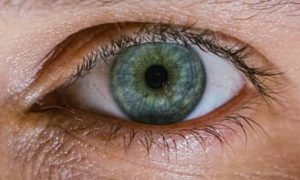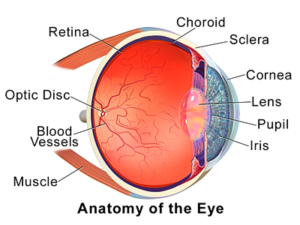
Let’s take a look at our eyes (pun intended). One of our most important senses, it contains an array of intricate parts that comprise the materials and intelligence for us to see. From one part to another, it’s like an assembly line of light. As the light passes through each component, the image that the eye sees gets more focused and adjusted for brightness or darkness.
The Parts of the Eye
Your eyes consist of numerous parts. Let’s focus on the main ones, which are the cornea, iris, pupil, lens, vitreous, and retina. We’ll start with the basic phenomenon of light entering the eye. What’s the first part in which the light hits?
The Cornea
The cornea is the front part of the eye. It is transparent and dome-shaped. Its function is to help the eye focus. Since it is transparent, you won’t notice it if you look in the mirror, but it is there. You could think of it as your window to the world.
The Iris
 Behind the cornea is the iris. Now, this component is very visible, as it is your eye color. So, if you have hazel eyes, it is the iris that you are looking at.
Behind the cornea is the iris. Now, this component is very visible, as it is your eye color. So, if you have hazel eyes, it is the iris that you are looking at.
The iris’s function is to control the amount of light received from the cornea. It is a regulating mechanism that knows when to shrink the pupil, which is behind the iris or when to widen it, in proportion to the amount of light that comes in. The regulating mechanism is a muscular component that controls this. If the iris is not working correctly, you will see too much brightness or not enough light, which, of course, will inhibit what you usually see.
The Pupil
The pupil is a dark opening situated in the focal point of the iris that permits light to strike the retina.
For those among us who are photographers, you will probably be interested in this analogy that you can think of the pupil as the lens aperture (how much the lens opens) and the iris as the F-Stop (the mechanism that controls the aperture). So when light hits your eye, it passes through the cornea and is intersected with the iris. The iris determines how much of an F-Stop setting is necessary and then that amount of light is passed to the pupil, which accepts that amount of light.
The Retina
The retina converts the surrounding image into electrical impulses. Like camera film or, for our millennial generation, a light sensor in a camera adjusts for the proper amount of light, then transfers this information into electrical signals that it sends to the brain.
More specifically, it converts light into electrical signals and then sends these signals to the brain for visual recognition. Using our camera analogy, it would be similar to the camera sensor, which acts as the CPU to determine the amount of light, colors, and dimensions and then translates that to neural impulses.
Just like the neurons in the brain, the retina contains layers of nerve cells interconnected by synapses. Some of these cells are light-sensing cells and are called photoreceptor cells, which convert light into electrical signals.
There is an outer layer of the retina called pigmented epithelial cells and contains two types of cells called rods and cones. Rods process dim light and cones process a well-lit environment, as well as determining color.
The following video explains how the eye works in a nutshell.
Summary
Our eyes are complex organs that convert the images that are sent to them into a visual perception that we humans can understand. We only brushed upon the basics of how our eyes work, but our intention was for you to get a general understanding of how they function and how they convert the light that hits our eyes into the objects that we see. See what I mean?
